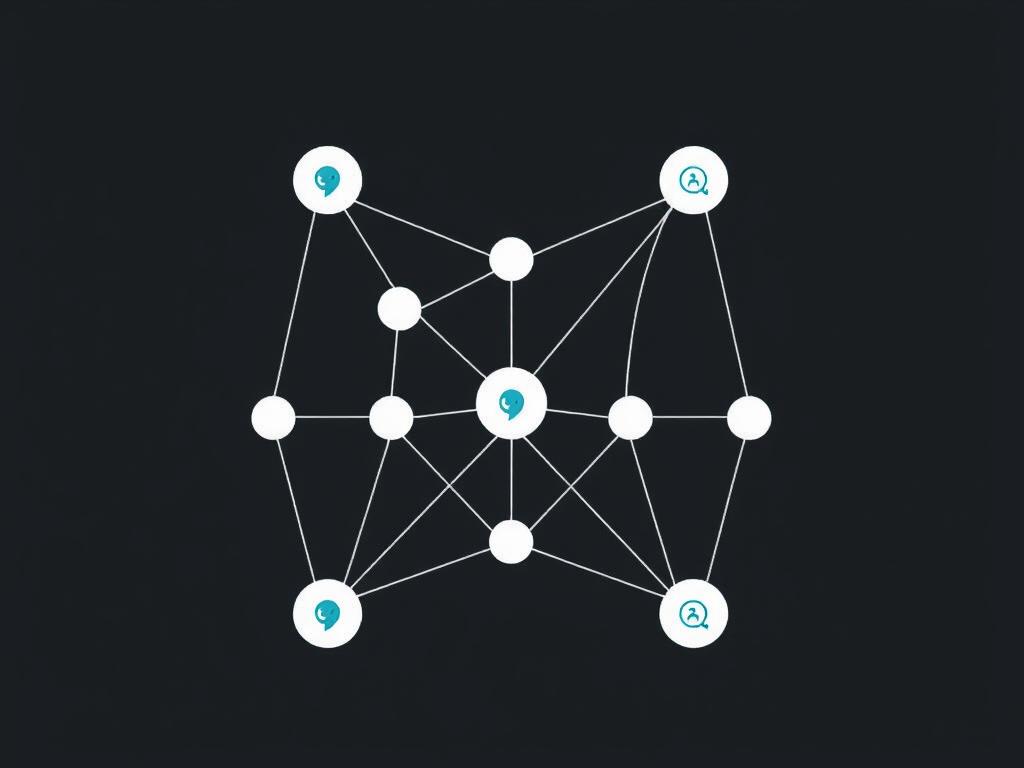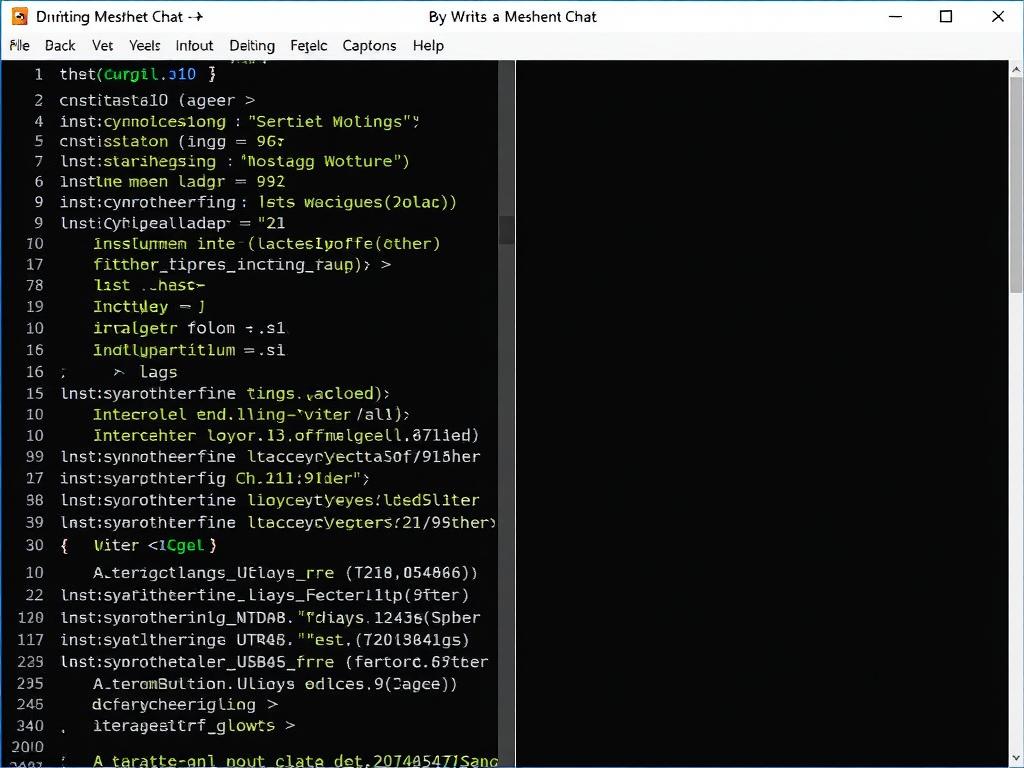Introduction to Meshnet Chat Apps
In today’s world, where we’re constantly connected through centralized servers and cloud services, the idea of a meshnet chat app might sound both futuristic and refreshing. Imagine a chatting platform that doesn’t rely on a single central server but instead connects users directly through a decentralized network. This is the power of a meshnet chat app. In this article, we’ll explore how to write a simple meshnet chat app in Python. Whether you’re a beginner or an intermediate Python enthusiast, you’ll find this journey engaging and comprehensible.
Meshnet chat apps capitalize on peer-to-peer (P2P) communication, providing greater privacy, resilience, and potentially improved speed for users. The ability to communicate without a centralized hub means the network is harder to disrupt and more democratic in nature. By building such an app in Python, you get hands-on experience with networking concepts, socket programming, and a glimpse into decentralized systems—all wrapped in a neat, simple project.
Understanding the Basics: What Makes a Meshnet Chat App?
Before diving into the code, let’s outline the core principles that make a meshnet chat app unique:
- Decentralization: No single server controls the communication. Every participant is both a client and a server.
- Peer-to-Peer Communication: Messages are sent directly between users’ devices.
- Dynamic Network: Nodes (users) can join or leave at will without disrupting the system.
- Message Propagation: Messages are forwarded across nodes to reach their destinations.
In contrast, traditional chat apps often rely on a central server to route messages, store chat histories, and manage user authentication. Although easier to build, centralized apps are prone to outages, privacy concerns, and censorship.
Setting Up Your Python Environment for the Meshnet Chat App
Before writing any code, you’ll want to prepare your Python environment. The Python standard library is quite powerful for socket programming, so external dependencies are minimal. However, having Python 3 installed along with a text editor or IDE is essential. You might also want to use virtual environments to keep your project files clean.
Here’s a simple checklist to get started:
- Install Python 3.6 or above
- Set up a project folder named
meshnet-chat - Choose an IDE: VSCode, PyCharm, or even a simple text editor
- Optionally, install
pipenvorvirtualenvfor environment management
Key Libraries to Know
Although the core will rely on Python’s built-in socket module, here are some helpful libraries you might use to add features later:
| Library | Purpose |
|---|---|
socket |
Low-level networking and peer-to-peer communication |
threading |
Handle multiple connections simultaneously |
select |
Monitor multiple socket connections effectively |
json |
Data serialization for messaging (optional) |
Step 1: Designing the Mesh Network Architecture

Every meshnet chat app needs a clear plan for how nodes discover each other, pass messages, and manage connections. Since we’re aiming for simplicity, we’ll take a few manageable assumptions:
- Each node will know about its peers via a list of IP addresses and ports.
- Messages will be broadcast to all known peers.
- Basic threading will help us handle listening and sending simultaneously.
This strategy sidesteps complex peer discovery algorithms, like those used in advanced mesh networks, but provides a solid foundation to build on.
Message Propagation Strategy
One key aspect is to prevent message loops—where messages bounce infinitely between nodes. A simple approach is:
- Assign a unique ID to each message
- Track received message IDs to avoid rebroadcasting duplicates
This way, messages spread through the mesh efficiently and stop once all nodes have received them.
Step 2: Writing the Python Code
Let’s break the coding into manageable parts: socket initialization, message sending, message receiving, and peer management.
Initializing the Socket
Each node opens a listening socket on a specific port for incoming messages. We use UDP or TCP; here, TCP may be simpler to ensure message delivery.
import socket
def init_socket(port):
s = socket.socket(socket.AF_INET, socket.SOCK_STREAM)
s.bind(('0.0.0.0', port))
s.listen()
return s
Managing Connections and Threads

Using Python’s threading module, we can listen for incoming connections while allowing the user to input outgoing messages.
import threading
def listen_for_peers(server_socket):
while True:
peer_socket, address = server_socket.accept()
threading.Thread(target=handle_peer, args=(peer_socket,)).start()
def handle_peer(peer_socket):
while True:
try:
data = peer_socket.recv(1024)
if not data:
break
# Process message here
except:
break
peer_socket.close()
Sending Messages to Peers

Since we know our peers’ IPs and ports, sending messages is straightforward:
def send_message(message, peer_address):
try:
s = socket.socket(socket.AF_INET, socket.SOCK_STREAM)
s.connect(peer_address)
s.sendall(message.encode('utf-8'))
s.close()
except Exception as e:
print(f"Could not send message to {peer_address}: {e}")
Step 3: Building the User Interface
You might be wondering how users will interact with the chat app. Since we’re keeping it simple, a command-line interface (CLI) is perfect. You can implement a function that:
- Prompts the user for chat messages
- Sends entered messages to peers
- Displays received messages in real-time
Threading allows user input without blocking message reception.
Example of Client Input Loop
def user_input_loop(peer_addresses, message_log):
while True:
message = input("> ")
if message.lower() == "exit":
break
for peer in peer_addresses:
send_message(message, peer)
message_log.append(("You", message))
Sample Meshnet Chat App Architecture Overview
To put it all together, here’s a summary table for your meshnet app’s components:
| Component | Function |
|---|---|
| Socket Listener | Accepts incoming connections and reads messages |
| Message Processor | Decodes incoming messages and prevents duplicate rebroadcasts |
| Sender | Sends messages to all known peers |
| User Interface | Accepts user input and displays chat content |
| Message Cache | Stores seen message IDs to prevent infinite loops |
Enhancing Your Simple Meshnet Chat App
Once you have the basics working, there’s so much more you can do to make your app robust, user-friendly, and scalable. Here are some ideas to explore:
- Peer Discovery: Automate the process of finding new peers using multicast or a discovery protocol.
- Encryption: Secure messages using TLS or libraries like
cryptographyto protect privacy. - Message Persistence: Save chat histories locally so users can see past conversations.
- GUI Integration: Build graphical user interfaces with
TkinterorPyQtfor a friendlier experience. - Improved Network Topology: Implement routing algorithms to optimize message paths.
Balancing Simplicity and Complexity
While it’s tempting to add many features, remember your aim: writing a simple meshnet chat app in Python. Start small, ensure your foundation is stable, and then gradually iterate. This approach not only reinforces learning but also prevents project overload.
Common Challenges and How to Overcome Them
Developing even a simple meshnet chat app introduces challenges. Here are some typical stumbling blocks and tips to navigate them:
- Connection Timeouts: Handle socket timeouts gracefully to keep the app running smoothly.
- Message Duplication: Implement robust message ID tracking to avoid spamming peers.
- Network Changes: Allow for dynamic peer updates when nodes enter or leave.
- Concurrency Issues: Use thread-safe data structures or synchronization mechanisms to prevent race conditions.
Understanding these challenges early empowers you to write better code and debug more effectively.
Final Thoughts on Building Your Own Meshnet Chat App
Writing a simple meshnet chat app in Python is an exciting project that opens the door to the fascinating world of decentralized communication. You gain practical skills in socket programming, concurrency, and network design, all while creating a useful tool. The beauty lies in its simplicity and the endless opportunities for expansion and enhancement.
Conclusion
In summary, creating a simple meshnet chat app in Python starts with grasping its core networking principles, setting up your Python environment, and carefully designing your app architecture. By combining socket programming with threading, you enable users to communicate directly in a decentralized mesh network. Although challenges exist, keeping the project straightforward and modular paves the way for future improvements like encryption, peer discovery, and GUI support. Whether you build this app for learning, experimentation, or practical use, it stands as a rewarding example of how Python empowers you to bring innovative ideas to life. So grab your keyboard, follow this guide step-by-step, and enjoy the process of building your own meshnet chat!
